British Indian actor Sabu (1924-1963) became an instant star with the release of the British film Elephant Boy (1937). He also starred as Abu, the thief in the Arabian fantasy-adventure The Thief of Bagdad (1940) and as Mowgli in Jungle Book (1942). Sabu had 'a smile as broad as the Ganges and charm enough to lure the stripes off a tiger'. His succession of tropical Technicolor treats delighted audiences before and during WW II. Although restricted to stereotypical roles, he was the first Indian actor to make it big in Hollywood.
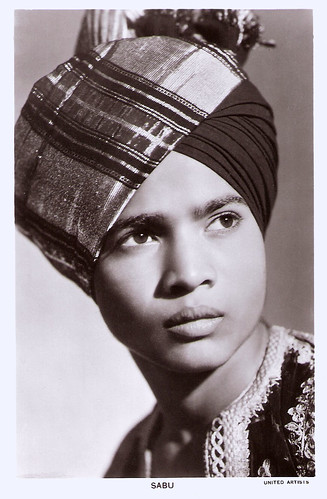
British postcard in the Picturegoer series, London, no. 1155. Photo: United Artists. Publicity still for The Drum (Zoltan Korda, 1938).
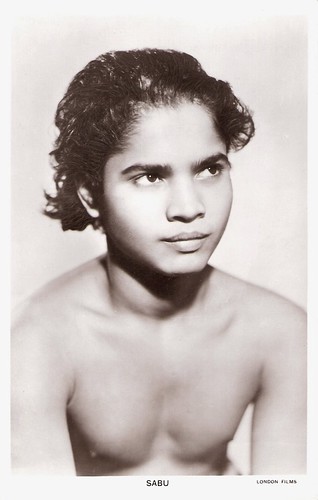
British postcard in the Picturegoer series, London, no. 1155b. Photo: London Films.
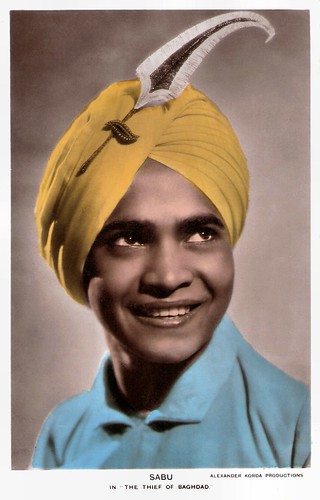
British postcard in the Colourgraph Series, London, no. C. 338. Photo: Alexander Korda Productions. Publicity still for The Thief of Baghdad (Ludwig Berger, Michael Powell, Tim Whelan, 1940).
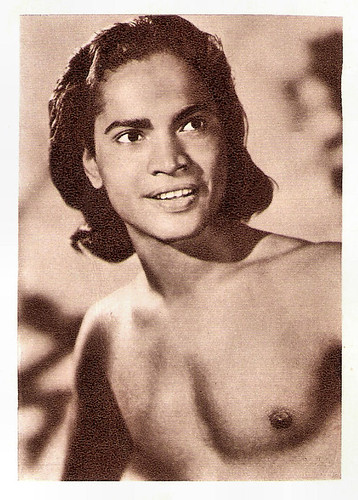
Vintage collectors card. Photo: publicity still for Jungle Book (Zoltan Korda, 1942) with Sabu as Mowgli.
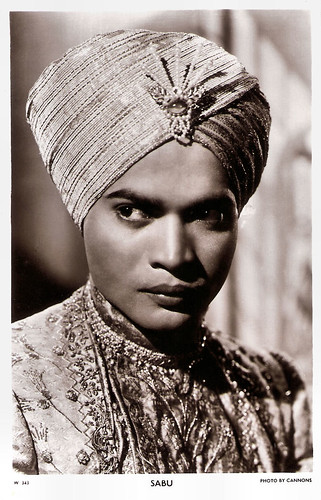
British postcard in the Picturegoer series, London, no. W 343. Photo: Cannons. Publicity still for Black Narcissus (Michael Powell, Emeric Pressburger, 1947).
Sabu was born in the jungles of Karapur, in the little town of Mysore in southern British India, in 1924. Most reference books list his full name as Sabu Dastigir, but research by journalist Philip Leibfried learned that this was his brother's first name, and that Sabu's full name was, in fact, Selar Shaik Sabu. Sabu's son Paul later confirmed this. Sabu's mother died when he was still very young and he was raised by his father, a Mahout (elephant driver) in service for the Maharajah of Mysore.
When his father also passed away in 1931, the six-year-old Sabu was taken into the service of the Maharajah of Mysore, first as a stable boy, then as a mahout in his own right. It was when riding one of his beloved elephants that director Robert Flaherty first saw him when looking for someone to play Toomai of the Elephants in his upcoming feature Elephant Boy (Robert J. Flaherty, Zoltán Korda, 1937), based on a story from The Jungle Books by Rudyard Kipling.
Filming began in the spring of 1935, but bad weather held up any real work until later that year. The film had a troubled two-year gestation, with Flaherty being replaced by producer Alexander Korda's brother, Zoltán Korda, mid-production and Sabu shipped over to England for six weeks of studio scenes. Alexander Korda was quite taken aback by Sabu's earnest looks, engaging naturalness and adaptability to wild animals and their natural habitat, and he placed the boy under an exclusive contract.
Sabu and his older brother (as a guardian) became subsequent wards of the British government. They were given schooling in the process and Sabu quickly learned the English language. Philip Leibfreid wrote in a 1989 article in Films in Review: "With a smile as broad as the Ganges and charm enough to lure the stripes off a tiger, the young Indian also added the authenticity needed in the lead role." The film was the official British entry at the Venice Film Festival that year where it won the award for best direction.
Elephant Boy was an unqualified hit and the young actor was promptly placed in The Drum (Zoltán Korda, 1938). He was surrounded by a cast that included Raymond Massey and Valerie Hobson. Philip Leibfried: "Filmed in the hills of South Wales, The Drum is the story of the friendship of an English drummer boy and an Indian prince whose father is assassinated by the boy's uncle, who plans a massacre of the British troops at a banquet. The prince discovers the plot and alerts the British by signalling his friend on a large drum. Shot in Technicolor and directed by Zoltán Korda, it holds up very well today."
Michael Brooke at BFIScreenonline adds: "Sabu's winning performance as heroic young Prince Azim showed that he had real range as an actor". Hollywood started taking a keen look at this refreshingly new talent when he first arrived in the US for a publicity tour. Again, his second film was given rave reviews, proving that Sabu would not be just a one-hit wonder. His third film for Alexander Korda, the Arabian fantasy-adventure The Thief of Baghdad (Ludwig Berger, Michael Powell, 1940) with Sabu as Abu the Thief, is even a true classic."
Philip Leibfried: "The Thief of Bagdad is one of the most wonderfully realized fantasy films ever produced. It contains all the elements of which dreams are made: a beautiful princess (June Duprez), a malevolent vizier (played to the hilt by Conrad Veidt), a genie in a bottle (superbly portrayed by black actor Rex Ingram), a fabulous jewel, a hidden temple, a giant spider, and a flying carpet - all presented in vivid Technicolor by design experts William Cameron Menzies (who had worked on the original film) and Vincent Korda. (...) When finally released on Christmas Day, 1940, The Thief of Bagdad was deservedly a smash hit, as well as winning Oscars for color cinematography, color art direction, and visual and sound special effects."
Sabu's name began stirring international ears. His last pairing with Korda was the adaptation of Rudyard Kipling's classic tale Jungle Book (Zoltán Korda, 1942) playing Mowgli. Leibfried writes: "Sabu was a natural for Mowgli, the feral child raised by a wolf pack. Animal footage was cleverly integrated with that of the humans so that the beasts seemed directly involved with the humans; only the snakes were models." Following this triumph, Sabu officially became the commodity of Universal Pictures and he settled in Hollywood. In 1944, almost 20 years old, he became a citizen of the USA.

Dutch postcard. Photo: Universal International.
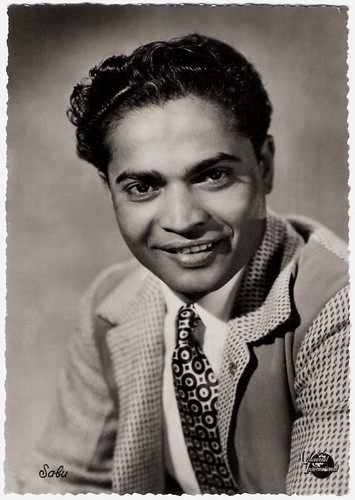
Belgian photo card by Fotoprim, Brussels, no. A 12, presented by De Beukelaer's factories for biscuits and chocolates, Antwerp. Photo: Universal Film.
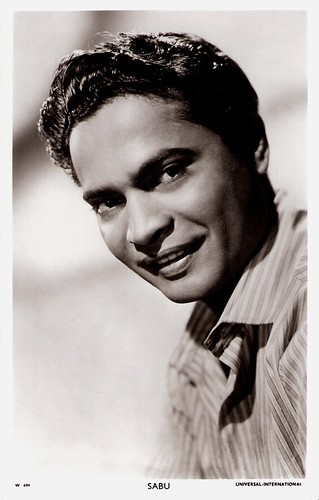
British postcard in the Picturegoer series, London, no. W 699. Photo: Universal-International.
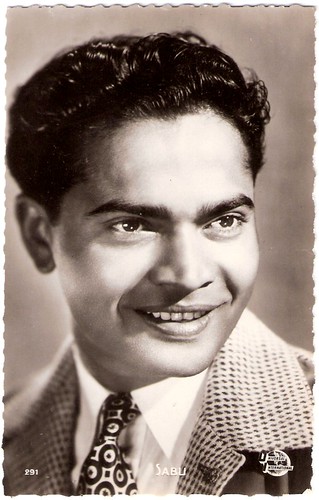
French postcard by Edition P.I., Paris, no. 291. Photo: Universal International.
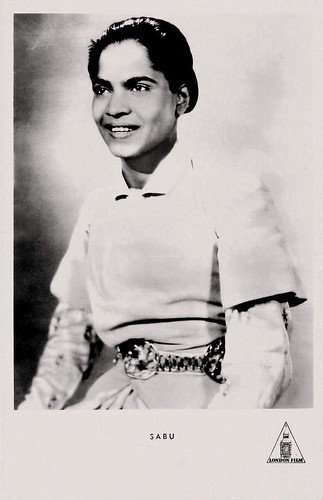
German postcard by Kunst und Bild, Berlin, no. A 265. Photo: London Films.
After becoming an American citizen, Sabu joined the US Army Air Force as a tail gunner. He flew several dozens of missions over the Pacific and was awarded the distinguished Flying Cross for his valour and bravery.
Unfortunately, Hollywood developed an assembly-line of empty-minded features for Sabu that hardly compared to his English quality pictures under Korda. He appeared in four films in support of 'The Queen of Technicolor', Maria Montez. At IMDb, Gary Brumburgh writes: "His vehicles Arabian Nights (John Rawlins, 1942), White Savage (Arthur Lubin, 1943), and Cobra Woman (Robert Siodmak, 1944) were, for the most part, drivel but fit the bill as colorful, mindless entertainment."
Sabu went back to England in 1946, starring in the crime drama The End of the River (Derek N. Twist, 1947) and appearing fourth-billed as the son of a native general in Black Narcissus (Michael Powell, Emeric Pressburger, 1947). His role in the exotic Technicolor extravaganza was not major but still important. Gary Brumburgh: "Daring in subject matter, the film had Deborah Kerr heading up a group of Anglican nuns who battle crude traditions, unexpected passions and stark raving madness while setting up a Himalayan order." Sabu appears about midway, wearing the scent that gives the story its title. He becomes the object of desire of a young pupil (Jean Simmons) and runs off with her.
While filming Song of India (Albert S. Rogell, 1949) in Hollywood, Sabu met and married actress Marilyn Cooper who temporarily filled in for an ailing Gail Russell on the set. The couple went on to have two children. Around 1950 Sabu had begun a successful contracting and real estate business which occupied most of his time when he was not acting.
Through most of the 1950s Sabu played in largely unsuccessful European films. In 1952, he appeared with an elephant act in Harringay Circus. Sabu was sued by an infant girl (born in 1948), through her mother, an unnamed unmarried English actress, who claimed to have had an affair with Sabu and that he was the infant's father. The suit was tried by a jury which returned a nine to three verdict in favour of Sabu.
His last two pictures were supporting roles in Rampage (Phil Karlson, 1963), which starred Robert Mitchum, and A Tiger Walks (Norman Tokar, 1964), according to Gary Brumburgh "a routine Disney picture which was released posthumously".
In 1963 Sabu suddenly died of a heart attack in Chatsworth, California. He was only 39. Sabu was survived by his wife Marilyn, his son Paul Sabu, who established the rock band Sabu in the 1980s, an his daughter Jasmine Sabu, who was an animal trainer on various films. Yasmine died in 2001.
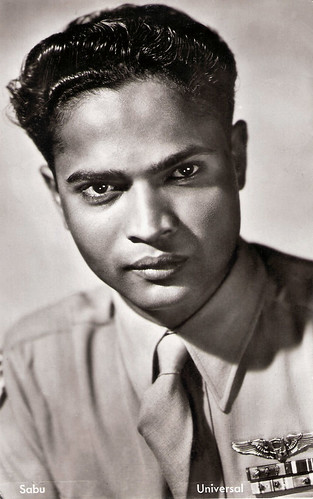
Dutch photo card by DRC, no. 17. Photo: MPEA.
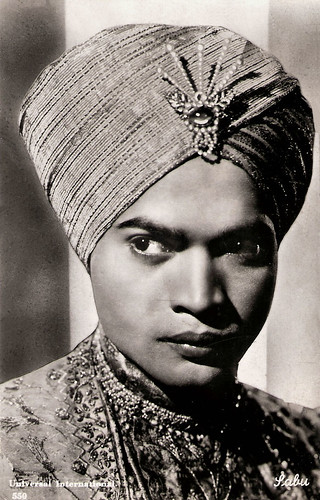
Vintage postcard, no. 550. Photo: Universal International. Publicity still for Black Narcissus (Michael Powell, Emeric Pressburger, 1947).
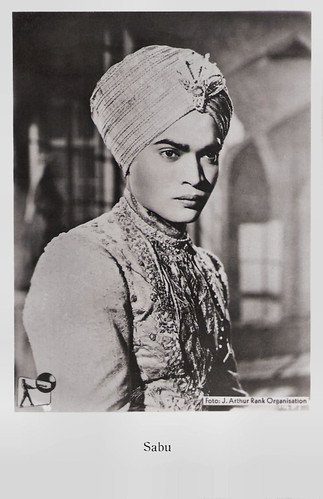
Dutch postcard. Photo: J. Arthur Rank Organisation. Publicity still for Black Narcissus (Michael Powell, Emeric Pressburger, 1947).
Trailer for The Thief of Bagdad (1940). Source: Flame Flamable (YouTube).
Trailer for Jungle Book (1942). Source: Adlerangriffe (YouTube).
Trailer for Black Narcissus (1947). Source: ryy79 (YouTube).
Sources: Gary Brumburgh (IMDb), Philip Leibfried (Films in Review), Michael Brooke (BFI Screenonline), Wikipedia, and IMDb.

British postcard in the Picturegoer series, London, no. 1155. Photo: United Artists. Publicity still for The Drum (Zoltan Korda, 1938).

British postcard in the Picturegoer series, London, no. 1155b. Photo: London Films.

British postcard in the Colourgraph Series, London, no. C. 338. Photo: Alexander Korda Productions. Publicity still for The Thief of Baghdad (Ludwig Berger, Michael Powell, Tim Whelan, 1940).

Vintage collectors card. Photo: publicity still for Jungle Book (Zoltan Korda, 1942) with Sabu as Mowgli.

British postcard in the Picturegoer series, London, no. W 343. Photo: Cannons. Publicity still for Black Narcissus (Michael Powell, Emeric Pressburger, 1947).
A smile as broad as the Ganges
Sabu was born in the jungles of Karapur, in the little town of Mysore in southern British India, in 1924. Most reference books list his full name as Sabu Dastigir, but research by journalist Philip Leibfried learned that this was his brother's first name, and that Sabu's full name was, in fact, Selar Shaik Sabu. Sabu's son Paul later confirmed this. Sabu's mother died when he was still very young and he was raised by his father, a Mahout (elephant driver) in service for the Maharajah of Mysore.
When his father also passed away in 1931, the six-year-old Sabu was taken into the service of the Maharajah of Mysore, first as a stable boy, then as a mahout in his own right. It was when riding one of his beloved elephants that director Robert Flaherty first saw him when looking for someone to play Toomai of the Elephants in his upcoming feature Elephant Boy (Robert J. Flaherty, Zoltán Korda, 1937), based on a story from The Jungle Books by Rudyard Kipling.
Filming began in the spring of 1935, but bad weather held up any real work until later that year. The film had a troubled two-year gestation, with Flaherty being replaced by producer Alexander Korda's brother, Zoltán Korda, mid-production and Sabu shipped over to England for six weeks of studio scenes. Alexander Korda was quite taken aback by Sabu's earnest looks, engaging naturalness and adaptability to wild animals and their natural habitat, and he placed the boy under an exclusive contract.
Sabu and his older brother (as a guardian) became subsequent wards of the British government. They were given schooling in the process and Sabu quickly learned the English language. Philip Leibfreid wrote in a 1989 article in Films in Review: "With a smile as broad as the Ganges and charm enough to lure the stripes off a tiger, the young Indian also added the authenticity needed in the lead role." The film was the official British entry at the Venice Film Festival that year where it won the award for best direction.
Elephant Boy was an unqualified hit and the young actor was promptly placed in The Drum (Zoltán Korda, 1938). He was surrounded by a cast that included Raymond Massey and Valerie Hobson. Philip Leibfried: "Filmed in the hills of South Wales, The Drum is the story of the friendship of an English drummer boy and an Indian prince whose father is assassinated by the boy's uncle, who plans a massacre of the British troops at a banquet. The prince discovers the plot and alerts the British by signalling his friend on a large drum. Shot in Technicolor and directed by Zoltán Korda, it holds up very well today."
Michael Brooke at BFIScreenonline adds: "Sabu's winning performance as heroic young Prince Azim showed that he had real range as an actor". Hollywood started taking a keen look at this refreshingly new talent when he first arrived in the US for a publicity tour. Again, his second film was given rave reviews, proving that Sabu would not be just a one-hit wonder. His third film for Alexander Korda, the Arabian fantasy-adventure The Thief of Baghdad (Ludwig Berger, Michael Powell, 1940) with Sabu as Abu the Thief, is even a true classic."
Philip Leibfried: "The Thief of Bagdad is one of the most wonderfully realized fantasy films ever produced. It contains all the elements of which dreams are made: a beautiful princess (June Duprez), a malevolent vizier (played to the hilt by Conrad Veidt), a genie in a bottle (superbly portrayed by black actor Rex Ingram), a fabulous jewel, a hidden temple, a giant spider, and a flying carpet - all presented in vivid Technicolor by design experts William Cameron Menzies (who had worked on the original film) and Vincent Korda. (...) When finally released on Christmas Day, 1940, The Thief of Bagdad was deservedly a smash hit, as well as winning Oscars for color cinematography, color art direction, and visual and sound special effects."
Sabu's name began stirring international ears. His last pairing with Korda was the adaptation of Rudyard Kipling's classic tale Jungle Book (Zoltán Korda, 1942) playing Mowgli. Leibfried writes: "Sabu was a natural for Mowgli, the feral child raised by a wolf pack. Animal footage was cleverly integrated with that of the humans so that the beasts seemed directly involved with the humans; only the snakes were models." Following this triumph, Sabu officially became the commodity of Universal Pictures and he settled in Hollywood. In 1944, almost 20 years old, he became a citizen of the USA.

Dutch postcard. Photo: Universal International.

Belgian photo card by Fotoprim, Brussels, no. A 12, presented by De Beukelaer's factories for biscuits and chocolates, Antwerp. Photo: Universal Film.

British postcard in the Picturegoer series, London, no. W 699. Photo: Universal-International.

French postcard by Edition P.I., Paris, no. 291. Photo: Universal International.

German postcard by Kunst und Bild, Berlin, no. A 265. Photo: London Films.
Colourful, Mindless Entertainment
After becoming an American citizen, Sabu joined the US Army Air Force as a tail gunner. He flew several dozens of missions over the Pacific and was awarded the distinguished Flying Cross for his valour and bravery.
Unfortunately, Hollywood developed an assembly-line of empty-minded features for Sabu that hardly compared to his English quality pictures under Korda. He appeared in four films in support of 'The Queen of Technicolor', Maria Montez. At IMDb, Gary Brumburgh writes: "His vehicles Arabian Nights (John Rawlins, 1942), White Savage (Arthur Lubin, 1943), and Cobra Woman (Robert Siodmak, 1944) were, for the most part, drivel but fit the bill as colorful, mindless entertainment."
Sabu went back to England in 1946, starring in the crime drama The End of the River (Derek N. Twist, 1947) and appearing fourth-billed as the son of a native general in Black Narcissus (Michael Powell, Emeric Pressburger, 1947). His role in the exotic Technicolor extravaganza was not major but still important. Gary Brumburgh: "Daring in subject matter, the film had Deborah Kerr heading up a group of Anglican nuns who battle crude traditions, unexpected passions and stark raving madness while setting up a Himalayan order." Sabu appears about midway, wearing the scent that gives the story its title. He becomes the object of desire of a young pupil (Jean Simmons) and runs off with her.
While filming Song of India (Albert S. Rogell, 1949) in Hollywood, Sabu met and married actress Marilyn Cooper who temporarily filled in for an ailing Gail Russell on the set. The couple went on to have two children. Around 1950 Sabu had begun a successful contracting and real estate business which occupied most of his time when he was not acting.
Through most of the 1950s Sabu played in largely unsuccessful European films. In 1952, he appeared with an elephant act in Harringay Circus. Sabu was sued by an infant girl (born in 1948), through her mother, an unnamed unmarried English actress, who claimed to have had an affair with Sabu and that he was the infant's father. The suit was tried by a jury which returned a nine to three verdict in favour of Sabu.
His last two pictures were supporting roles in Rampage (Phil Karlson, 1963), which starred Robert Mitchum, and A Tiger Walks (Norman Tokar, 1964), according to Gary Brumburgh "a routine Disney picture which was released posthumously".
In 1963 Sabu suddenly died of a heart attack in Chatsworth, California. He was only 39. Sabu was survived by his wife Marilyn, his son Paul Sabu, who established the rock band Sabu in the 1980s, an his daughter Jasmine Sabu, who was an animal trainer on various films. Yasmine died in 2001.

Dutch photo card by DRC, no. 17. Photo: MPEA.

Vintage postcard, no. 550. Photo: Universal International. Publicity still for Black Narcissus (Michael Powell, Emeric Pressburger, 1947).

Dutch postcard. Photo: J. Arthur Rank Organisation. Publicity still for Black Narcissus (Michael Powell, Emeric Pressburger, 1947).
Trailer for The Thief of Bagdad (1940). Source: Flame Flamable (YouTube).
Trailer for Jungle Book (1942). Source: Adlerangriffe (YouTube).
Trailer for Black Narcissus (1947). Source: ryy79 (YouTube).
Sources: Gary Brumburgh (IMDb), Philip Leibfried (Films in Review), Michael Brooke (BFI Screenonline), Wikipedia, and IMDb.
2 comments:
Raymond Massey was Canadian, in fact, until he took American citizenship later in life. His younger brother Vincent became our first Canadian-born Governor General of Canada.
Thanks for your comment. We've changed it.
Post a Comment